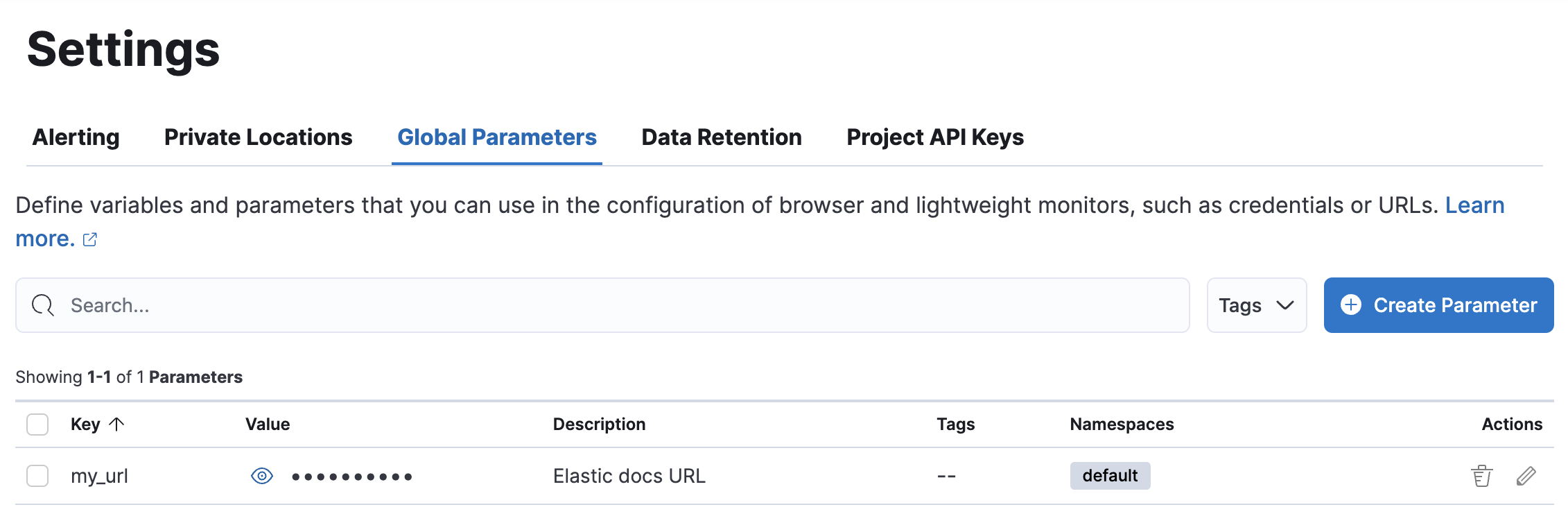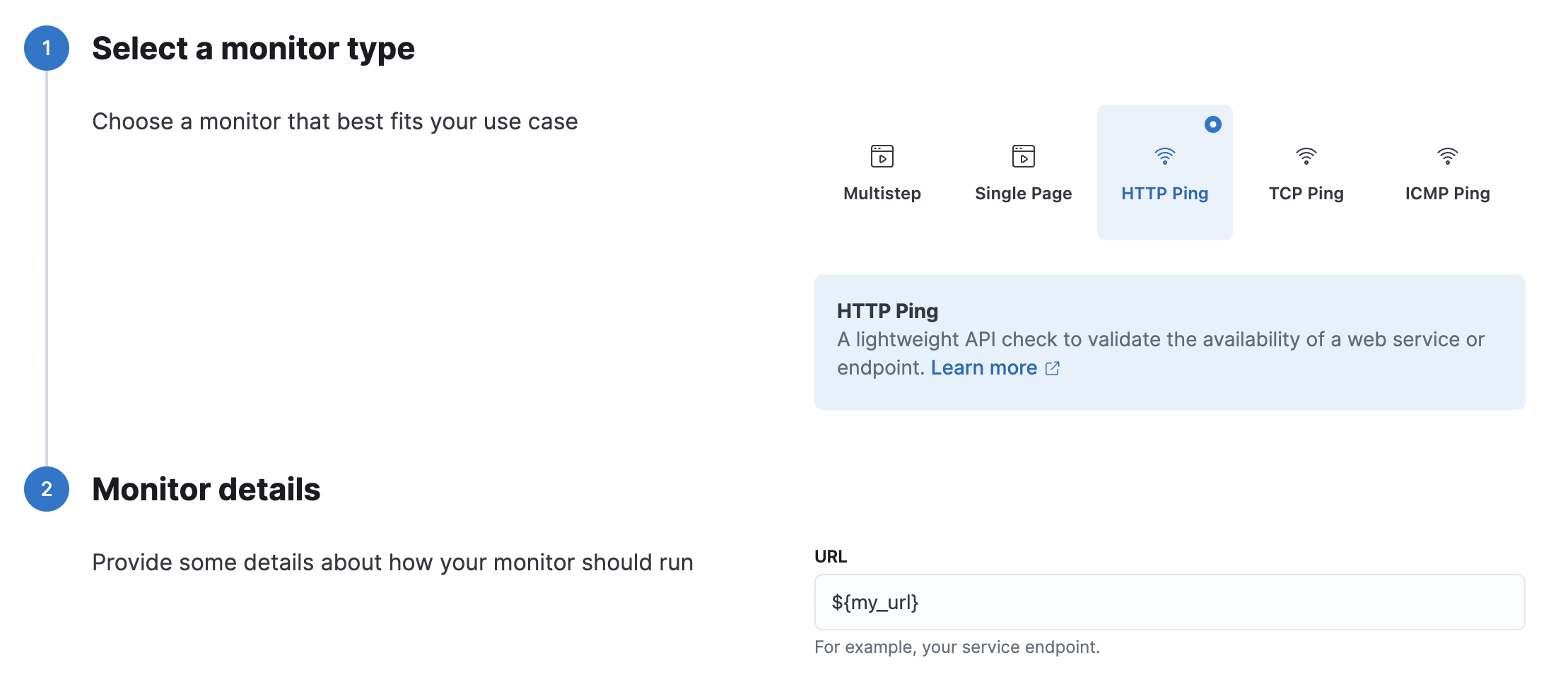- Elastic Cloud Serverless
- Elasticsearch
- Elastic Observability
- Get started
- Observability overview
- Elastic Observability Serverless billing dimensions
- Create an Observability project
- Quickstart: Monitor hosts with Elastic Agent
- Quickstart: Monitor your Kubernetes cluster with Elastic Agent
- Quickstart: Monitor hosts with OpenTelemetry
- Quickstart: Unified Kubernetes Observability with Elastic Distributions of OpenTelemetry (EDOT)
- Quickstart: Collect data with AWS Firehose
- Get started with dashboards
- Applications and services
- Application performance monitoring (APM)
- Get started with traces and APM
- Learn about data types
- Collect application data
- View and analyze data
- Act on data
- Use APM securely
- Reduce storage
- Managed intake service event API
- Troubleshooting
- Synthetic monitoring
- Get started
- Scripting browser monitors
- Configure lightweight monitors
- Manage monitors
- Work with params and secrets
- Analyze monitor data
- Monitor resources on private networks
- Use the CLI
- Configure a Synthetics project
- Multifactor Authentication for browser monitors
- Configure Synthetics settings
- Grant users access to secured resources
- Manage data retention
- Scale and architect a deployment
- Synthetics Encryption and Security
- Troubleshooting
- Application performance monitoring (APM)
- Infrastructure and hosts
- Logs
- Inventory
- Incident management
- Data set quality
- Observability AI Assistant
- Machine learning
- Reference
- Get started
- Elastic Security
- Elastic Security overview
- Security billing dimensions
- Create a Security project
- Elastic Security requirements
- Elastic Security UI
- AI for Security
- Ingest data
- Configure endpoint protection with Elastic Defend
- Manage Elastic Defend
- Endpoints
- Policies
- Trusted applications
- Event filters
- Host isolation exceptions
- Blocklist
- Optimize Elastic Defend
- Event capture and Elastic Defend
- Endpoint protection rules
- Identify antivirus software on your hosts
- Allowlist Elastic Endpoint in third-party antivirus apps
- Elastic Endpoint self-protection features
- Elastic Endpoint command reference
- Endpoint response actions
- Cloud Security
- Explore your data
- Dashboards
- Detection engine overview
- Rules
- Alerts
- Advanced Entity Analytics
- Investigation tools
- Asset management
- Manage settings
- Troubleshooting
- Manage your project
- Changelog
Work with params and secrets
editWork with params and secrets
editParams allow you to use dynamically defined values in your synthetic monitors. For example, you may want to test a production website with a particular demo account whose password is only known to the team managing the synthetic monitors.
For more information about security-sensitive use cases, refer to Working with secrets and sensitive values.
Define params
editParam values can be declared by any of the following methods:
- In the Global parameters tab of the Synthetics Settings page in an Observability project.
- Declaring a default value for the parameter in a configuration file.
-
Passing the
--paramsCLI argument.
If you are creating and managing synthetic monitors using a
Synthetics project, you can also use regular environment
variables via the standard node process.env global object.
The values in the configuration file are read in the following order:
- Global parameters in an Observability project: The Global parameters set using the Observability project’s UI are read first.
- Configuration file: Then the Global parameters are merged with any parameters defined in a configuration file. If a parameter is defined in both the Observability project and a Synthetics project configuration file, the value in the configuration file will be used.
-
CLI: Then the parameters defined in the configuration are merged with any parameters passed to the CLI
--paramsargument. If a parameter is defined in a Synthetics project configuration file and using the CLI argument, the value defined using the CLI will be used. When running a script using the CLI, Global parameters defined in the Observability project have no impact on the test because it won’t have access to the Observability project.
Global parameters in your Observability project
editFrom any page in the Observability project’s Synthetics section:
- Go to Settings.
- Go to the Global parameters tab.
- Define parameters.

Synthetics project config file
editUse a synthetics.config.js or synthetics.config.ts file to define variables required by your tests.
This file should be placed in the root of your Synthetics project.
export default (env) => { let my_url = "http://localhost:8080"; if (env === "production") { my_url = "https://elastic.github.io/synthetics-demo/" } return { params: { my_url, }, }; };
The example above uses the env variable, which corresponds to the value of the NODE_ENV environment variable.
CLI argument
editTo set parameters when running npx @elastic/synthetics on the command line,
use the --params or -p flag. The provided map is merged over any existing variables defined in the synthetics.config.{js,ts} file.
For example, to override the my_url parameter, you would run:
npx @elastic/synthetics . --params '{"my_url": "http://localhost:8080"}'
Use params
editYou can use params in both lightweight and browser monitors created in either a Synthetics project or the Synthetics UI in your Observability project.
In a Synthetics project
editFor lightweight monitors in a Synthetics project, wrap the name of the param in ${} (for example, ${my_url}).
- type: http name: Todos Lightweight id: todos-lightweight urls: ["${my_url}"] schedule: '@every 1m'
In browser monitors, parameters can be referenced via the params property available within the
argument to a journey, before, beforeAll, after, or afterAll callback function.
Add params. before the name of the param (for example, params.my_url):
beforeAll(({params}) => { console.log(`Visiting ${params.my_url}`) }) journey("My Journey", ({ page, params }) => { step('launch app', async () => { await page.goto(params.my_url) }) })
In the UI
editTo use a param in a lightweight monitor that is created in the Synthetics UI,
wrap the name of the param in ${} (for example, ${my_url}).

To use a param in a browser monitor that is created in the Synthetics UI,
add params. before the name of the param (for example, params.my_url).

Working with secrets and sensitive values
editYour synthetics scripts may require the use of passwords or other sensitive secrets that are not known until runtime.
Params are viewable in plain-text by administrators and other users with all privileges for
the Synthetics app.
Also note that synthetics scripts have no limitations on accessing these values, and a malicious script author could write a
synthetics journey that exfiltrates params and other data at runtime.
Do not use truly sensitive passwords (for example, an admin password or a real credit card)
in any synthetics tools.
Instead, set up limited demo accounts, or fake credit cards with limited functionality.
If you want to limit access to parameters, ensure that users who are not supposed to access those values
do not have all privileges for the Synthetics app, and that any scripts that use those values
do not leak them in network requests or screenshots.
If you are managing monitors with a Synthetics project, you can use environment variables
in your synthetics.config.ts or synthetics.config.js file.
The example below uses process.env.MY_URL to reference a variable named MY_URL
defined in the environment and assigns its value to a param. That param can then
be used in both lightweight and browser monitors that are managed in the Synthetics project:
export default { params: { my_url: process.env.MY_URL } };
On this page